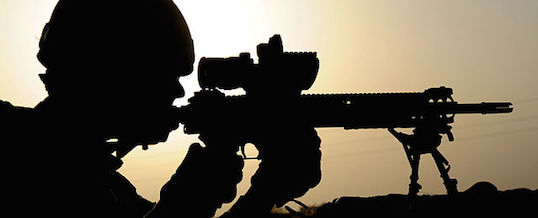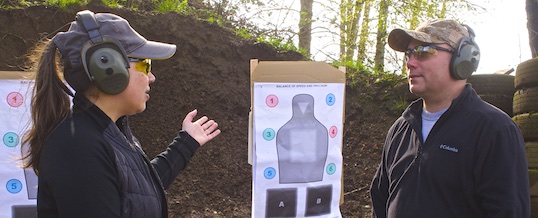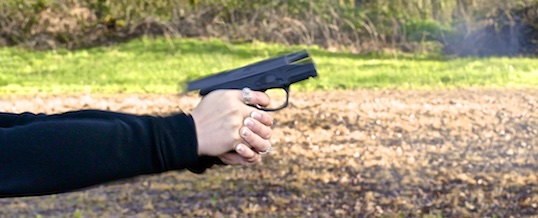
Do you need backup sights on a defensive rifle? It depends.
Do you need backup sights (BUS or BUIS – “backup iron sights”) on your defensive rifle? The answer is a solid “maybe”, because the choice might not be as clear-cut as you may think.
This year’s Bullpup Rifle Experiment taught me a lot; not just about bullpup rifles, but about rifles in general and how we use them. The bullpup’s relative lack of accessory rail space, plus the compacted layout, forced me to think harder about how any rifle should be set up for defensive use and by extension how I equip all of my own rifles.
In years past I’ve avoided optics on my long guns for several reasons, not the least of which was that my eyesight was more than sufficient to make use of the standard iron sights. That’s changed as time has progressed, and now that my eyeglass prescription gets a little stronger every couple of years I’ve been convinced to put optics on my rifles. (The actual choice of optic is another story; you can read about that in this article.)
Along with optic I’d pretty much decided that I needed backup sights as well. Everyone else has them, so I uncritically assumed I should as well. That was my first mistake: not questioning what I’d been told!
Where did these things come from?
Let’s look at the very idea of backup sights. I can’t remember ever seeing such devices until relatively recently; looking at almost all military issued rifles up until the mid-nineties, for instance, you saw one set of iron sights — period. On occasion a hunting rifle would have iron sights and a quick-detach scope, but those weren’t backup sights in the sense we use the term today. They were auxiliary sights, used when the scope (which was usually a fixed 4- or 6-power) wasn’t appropriate. In such cases the quick-release was used to remove the scope and the whole thing was reattached when needed again.
The backup sight, which is a device meant to be used in emergency replacement for a primary sighting system, came into its own when optical sights (and more specifically, red dot sights) came into widespread use. The idea was that if the primary sighting optic was working the shooter could quickly transition to the backup sights and continue firing.
The appeal to the defensive shooter should be obvious: in a lethal encounter where the primary optic had become unusable it would seem prudent to have another method of aiming the gun at the threat. How valid is that?
Why are they needed?
There are really only two possible reasons for a primary optic to become unusable: either it is damaged beyond use, or some sort of failure inside of the optic occurs.
Let’s look at the idea of damage to the scope. In this day and age, I think you’d find it pretty hard to damage any decent scope to the point that it was completely unusable. I’ll even go out on a limb and suggest that the optics we have today are, in the physical sense, more rugged and durable than the iron sights they replace. Iron sights are surprisingly easy to break; even a short drop can snap the blade off of a stock FN-FAL rear sight, for instance (yes, I’ve done it) and I’ve seen damaged front sight posts on AR-15 rifles. Even so, no one ever suggested backup sights for iron sights! They simply weren’t felt necessary.
I couldn’t have said the same in the early days of scope manufacturing. Prior to about 1980, scopes were designed to resist recoil impulses from the rifle and not external impact coming from other directions. Optics have come a long way since, largely due to the success of products such as the integrated optic that Steyr-Mannlicher put on their AUG rifle in the late ‘70s. Since then scopes of all kinds have gotten a lot tougher, and scopes intended for military and police use are in a class by themselves in terms of durability.
Given the products we have today I feel comfortable in predicting that a good quality scope will easily hold up against any plausible happenstance, and that anything which would be able to render a modern scope useless would also do operational damage to the rifle on which it sits — and likely severely injure, if not kill outright, the person holding it.
So much for damage; what about scope failure? This is where the idea of backup sights really came from. In the last twenty years we’ve seen a huge market erupt for red dot sights: zero-magnification (“1x”) optics which project a battery-powered LED dot into what appears to be the same plane as the target. They’re fast and easy to use and make training new rifle shooters incredibly easy, making their popularity easy to understand. They’re also physically quite rugged, with the better models being as tough as their optical-sight brethren — if not more so.
The problem isn’t the physical construction, however; it’s the electronics that actually make the scopes work. They’re still subject to all kinds of issues, from suddenly depleted batteries to bad battery contacts to switch failures to circuitry problems. The do stop working on occasion (I’ve seen more than a few broken ones on the firing line), even without rough handling, and more often than their manufacturers would like to admit.
It shouldn’t come as a coincidence, then, that the rise of the BUS/BUIS coincided with the ascension of the red dot scope!
What’s your expected use?
I’ve come to believe that, in general, if you have a sight which is dependent on a battery-operated circuit to simply function that you strongly consider a backup sighting system of some kind. That doesn’t have to be iron sights; it could be a laser, for instance. The concept is to supplement something which you know has a certain failure rate with something that can do its job at least passably.
If, on the other hand, your primary scope doesn’t require the use of batteries (or the batteries are supplemental in some fashion, like making an existing black reticle glow red) I see much less need for a BUS/BUIS system. Again, we’re talking about sights that are realistically as durable as the metal sights we used to use — and since we never found the need for backups for those, I don’t see why we really need them for the ultra-rugged optical sights we have today.
My personal rifle
This is the approach I’ve taken with my personal rifles: I’ve equipped them with a 1-4 power scope (specifically the Meopta MeoTac 1-4×22 RD) which uses batteries only to illuminate the reticle and which is perfectly usable even if the battery system fails in some manner. Since it has a true zero-magnification setting, which is where it stays unless I feel the need for a better view of the target, it doesn’t need to compensate for lack of short-range capability. Since it’s also built incredibly well I don’t worry about it being destroyed, doubly so because I’m not taking it into a war zone for extended periods of deployment.
The result is that I no longer feel a need for any sort of backup sights on those rifles that are so equipped. The scope I’ve chosen doesn’t need them, and the use to which I’m putting them doesn’t either. The backup sight makes some sense when we’re talking about all-electronic red dot optics, but the justification disappears when the primary sight is more carefully chosen. In many cases they’re simply bought because everyone else has them.
Look at your equipment with the same critical eye you should cast on your training. Not everything has a reason, and sometimes that reason may not be applicable to your life.
Besides, the money saved can be better spent on more ammunition and practice time!
– Grant Cunningham
- Posted by Grant Cunningham
- On December 14, 2015



